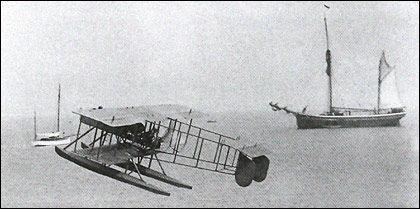| Terrence I. Murphy, e-mail, 14.02.2012 18:49 After the crash of the prototype on July 10, 1913, the changes made to the original design were more drastic. The work was completed by the 21 August 1913, when the machine, now known as the Navyplane, was launched and flown successfully two days later by Gordon England.
The changes introduced were mainly to the tail booms and tail unit. The top and bottom members of the booms were opened up in elevation, with an extra bay introduced, and slightly towed in in plan. A larger rectangular tailplane was mounted on top with a one piece elevator and twin rudders of a new shape below. There was no fin.
Although the floats were unchanged initially, considerable changes were made to the chassis. Struts were introduced between the floats, and these were anchored at the center to vee struts under the nacelle and center section. Long struts were added from the top center section to near the tips of each float, when new floats were fitted in September.
Soon after, a land undercarriage was tried and the machine was tested with this in fields near Cowes at Northwood, until the machine was damaged early in 1914. The machine was then put aside until refurbished as a seaplane at the outbreak of war, when it was acquired by the Admiralty. It was fitted with dual controls and used as a trainer at Calshot and Warsash until June 1915.
Data
Span top 44ft
Span bottom 40ft
Chord top 6ft 6in
Chord bottom 5ft 6in
Floats 21ft long by 2ft 6in beam
Area 500 sq. ft
Length 31ft 6in
Height lift 6in
Weight allup 2,4001b.
Speed range 35-70 mph
Climb 400 ft per min
Endurance 2 3 /4 hr reply |









